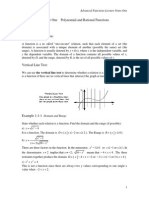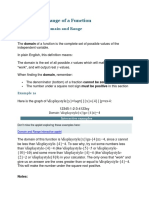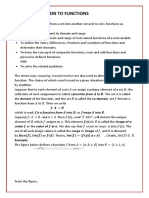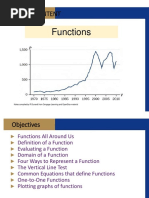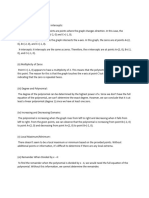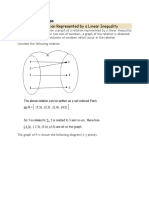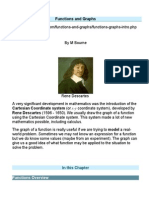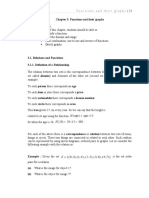1.3 Functions and Their Graphs
1.3 Functions and Their Graphs
Uploaded by
Jagathisswary SatthiCopyright:
Available Formats
1.3 Functions and Their Graphs
1.3 Functions and Their Graphs
Uploaded by
Jagathisswary SatthiOriginal Title
Copyright
Available Formats
Share this document
Did you find this document useful?
Is this content inappropriate?
Copyright:
Available Formats
1.3 Functions and Their Graphs
1.3 Functions and Their Graphs
Uploaded by
Jagathisswary SatthiCopyright:
Available Formats
1.
3 Functions and Their Graphs 19
Functions and Their Graphs
Functions are the major objects we deal with in calculus because they are key to describ-
ing the real world in mathematical terms. This section reviews the ideas of functions, their
graphs, and ways of representing them.
Functions; Domain and Range
The temperature at which water boils depends on the elevation above sea level (the boiling
point drops as you ascend). The interest paid on a cash investment depends on the length of
time the investment is held. The area of a circle depends on the radius of the circle. The dis-
tance an object travels froman initial location along a straight line path depends on its speed.
In each case, the value of one variable quantity, which we might call y, depends on the
value of another variable quantity, which we might call x. Since the value of y is com-
pletely determined by the value of x, we say that y is a function of x. Often the value of y is
given by a rule or formula that says how to calculate it from the variable x. For instance,
the equation is a rule that calculates the area A of a circle from its radius r.
In calculus we may want to refer to an unspecified function without having any partic-
ular formula in mind. A symbolic way to say y is a function of x is by writing
In this notation, the symbol represents the function. The letter x, called the independent
variable, represents the input value of , and y, the dependent variable, represents the
corresponding output value of at x.
y = sxd sy equals of xd
A = pr
2
1.3
DEFINITION Function
A function from a set D to a set Y is a rule that assigns a unique (single) element
to each element x H D. sxd H Y
The set D of all possible input values is called the domain of the function. The set of
all values of (x) as x varies throughout D is called the range of the function. The range
may not include every element in the set Y.
The domain and range of a function can be any sets of objects, but often in calculus
they are sets of real numbers. (In Chapters 1316 many variables may be involved.)
Think of a function as a kind of machine that produces an output value (x) in its
range whenever we feed it an input value x from its domain (Figure 1.22). The function
Input
(domain)
Output
(range)
x f (x) f
FIGURE 1.22 A diagram showing a
function as a kind of machine.
4100 AWL/Thomas_ch01p001-072 8/19/04 10:50 AM Page 19
Copyright 2005 Pearson Education, Inc., publishing as Pearson Addison-Wesley
20 Chapter 1: Preliminaries
keys on a calculator give an example of a function as a machine. For instance, the key
on a calculator gives an output value (the square root) whenever you enter a nonnegative
number x and press the key. The output value appearing in the display is usually a deci-
mal approximation to the square root of x. If you input a number then the calculator
will indicate an error because is not in the domain of the function and cannot be ac-
cepted as an input. The key on a calculator is not the same as the exact mathematical
function defined by because it is limited to decimal outputs and has only fi-
nitely many inputs.
A function can also be pictured as an arrow diagram (Figure 1.23). Each arrow
associates an element of the domain D to a unique or single element in the set Y. In Figure
1.23, the arrows indicate that (a) is associated with a, (x) is associated with x, and so on.
The domain of a function may be restricted by context. For example, the domain of
the area function given by only allows the radius r to be positive. When we de-
fine a function with a formula and the domain is not stated explicitly or re-
stricted by context, the domain is assumed to be the largest set of real x-values for which
the formula gives real y-values, the so-called natural domain. If we want to restrict the
domain in some way, we must say so. The domain of is the entire set of real num-
bers. To restrict the function to, say, positive values of x, we would write
Changing the domain to which we apply a formula usually changes the range as well.
The range of is The range of is the set of all numbers ob-
tained by squaring numbers greater than or equal to 2. In set notation, the range is
or or
When the range of a function is a set of real numbers, the function is said to be real-
valued. The domains and ranges of many real-valued functions of a real variable are inter-
vals or combinations of intervals. The intervals may be open, closed, or half open, and may
be finite or infinite.
EXAMPLE 1 Identifying Domain and Range
Verify the domains and ranges of these functions.
Function Domain (x) Range ( y)
[0, 1]
Solution The formula gives a real y-value for any real number x, so the domain
is The range of is because the square of any real number is
nonnegative and every nonnegative number y is the square of its own square root,
for
The formula gives a real y-value for every x except We cannot divide
any number by zero. The range of the set of reciprocals of all nonzero real num-
bers, is the set of all nonzero real numbers, since
The formula gives a real y-value only if The range of is
because every nonnegative number is some numbers square root (namely, it is the
square root of its own square).
[0, qd
y = 2x x 0. y = 2x
y = 1>(1>y).
y = 1>x,
x = 0. y = 1>x
y 0. y = A 2yB
2
[0, qd y = x
2
s - q, qd.
y = x
2
[-1, 1] y = 21 - x
2
[0, qd s - q, 4] y = 24 - x
[0, qd [0, qd y = 2x
s - q, 0d s0, qd s - q, 0d s0, qd y = 1/x
[0, qd s - q, qd y = x
2
[4, qd. 5y y 46 5x
2
x 26
y = x
2
, x 2, [0, qd. y = x
2
y = x
2
, x 7 0.
y = x
2
y = sxd
A = pr
2
sxd = 2x
2x
x 6 0
x 6 0,
2x
2x
x
a
f (a)
f (x)
D domain set Y set containing
the range
FIGURE 1.23 A function from a set D to
a set Y assigns a unique element of Y to
each element in D.
4100 AWL/Thomas_ch01p001-072 8/19/04 10:50 AM Page 20
Copyright 2005 Pearson Education, Inc., publishing as Pearson Addison-Wesley
1.3 Functions and Their Graphs 21
In the quantity cannot be negative. That is, or
The formula gives real y-values for all The range of is
the set of all nonnegative numbers.
The formula gives a real y-value for every x in the closed interval
from to 1. Outside this domain, is negative and its square root is not a real
number. The values of vary from 0 to 1 on the given domain, and the square roots
of these values do the same. The range of is [0, 1].
Graphs of Functions
Another way to visualize a function is its graph. If is a function with domain D, its graph
consists of the points in the Cartesian plane whose coordinates are the input-output pairs
for . In set notation, the graph is
The graph of the function is the set of points with coordinates (x, y) for
which Its graph is sketched in Figure 1.24.
The graph of a function is a useful picture of its behavior. If (x, y) is a point on the
graph, then is the height of the graph above the point x. The height may be posi-
tive or negative, depending on the sign of (Figure 1.25). sxd
y = sxd
y = x + 2.
sxd = x + 2
5sx, sxdd x H D6.
21 - x
2
1 - x
2
1 - x
2
-1
y = 21 - x
2
[0, qd, 24 - x x 4. x 4.
4 - x 0, 4 - x y = 24 - x,
x
y
2 0
2
y x 2
FIGURE 1.24 The graph of
is the set of points (x, y) for
which y has the value x + 2.
sxd = x + 2
y
x
0 1 2
x
f (x)
(x, y)
f (1)
f (2)
FIGURE 1.25 If (x, y) lies on the graph of
f, then the value is the height of
the graph above the point x (or below x if
(x) is negative).
y = sxd
EXAMPLE 2 Sketching a Graph
Graph the function over the interval
Solution
1. Make a table of xy-pairs that satisfy the function rule, in this case the equation y = x
2
.
[-2, 2]. y = x
2
x
4
1
0 0
1 1
2 4
9
4
3
2
-1
-2
y x
2
4100 AWL/Thomas_ch01p001-072 8/19/04 10:50 AM Page 21
Copyright 2005 Pearson Education, Inc., publishing as Pearson Addison-Wesley
How do we know that the graph of doesnt look like one of these curves? y = x
2
22 Chapter 1: Preliminaries
y x
2
?
x
y
y x
2
?
x
y
0
50
100
150
200
250
300
350
10 20 30 40 50
Time (days)
t
p
FIGURE 1.26 Graph of a fruit fly
population versus time (Example 3).
2. Plot the points (x, y) whose
coordinates appear in the table. Use
fractions when they are convenient
computationally.
3. Draw a smooth curve through the
plotted points. Label the curve with
its equation.
0 1 2 1 2
1
2
3
4
(2, 4)
(1, 1) (1, 1)
(2, 4)
3
2
9
4
,
x
y
0 1 2 1 2
1
2
3
4
x
y
y x
2
To find out, we could plot more points. But how would we then connect them? The
basic question still remains: How do we know for sure what the graph looks like
between the points we plot? The answer lies in calculus, as we will see in Chapter 4.
There we will use the derivative to find a curves shape between plotted points. Mean-
while we will have to settle for plotting points and connecting them as best we can.
EXAMPLE 3 Evaluating a Function from Its Graph
The graph of a fruit fly population p is shown in Figure 1.26.
(a) Find the populations after 20 and 45 days.
(b) What is the (approximate) range of the population function over the time interval
Solution
(a) We see from Figure 1.26 that the point (20, 100) lies on the graph, so the value of the
population p at 20 is Likewise, p(45) is about 340.
(b) The range of the population function over is approximately [0, 345]. We
also observe that the population appears to get closer and closer to the value
as time advances.
p = 350
0 t 50
ps20d = 100.
0 t 50?
Computers and graphing calculators
graph functions in much this wayby
stringing together plotted pointsand
the same question arises.
4100 AWL/Thomas_ch01p001-072 8/19/04 10:50 AM Page 22
Copyright 2005 Pearson Education, Inc., publishing as Pearson Addison-Wesley
1.3 Functions and Their Graphs 23
Representing a Function Numerically
We have seen how a function may be represented algebraically by a formula (the area
function) and visually by a graph (Examples 2 and 3). Another way to represent a function
is numerically, through a table of values. Numerical representations are often used by en-
gineers and applied scientists. From an appropriate table of values, a graph of the function
can be obtained using the method illustrated in Example 2, possibly with the aid of a com-
puter. The graph of only the tabled points is called a scatterplot.
EXAMPLE 4 A Function Defined by a Table of Values
Musical notes are pressure waves in the air that can be recorded. The data in Table 1.2 give
recorded pressure displacement versus time in seconds of a musical note produced by a
tuning fork. The table provides a representation of the pressure function over time. If we
first make a scatterplot and then connect the data points (t, p) from the table, we obtain the
graph shown in Figure 1.27.
TABLE 1.2 Tuning fork data
Time Pressure Time Pressure
0.00091 0.00362 0.217
0.00108 0.200 0.00379 0.480
0.00125 0.480 0.00398 0.681
0.00144 0.693 0.00416 0.810
0.00162 0.816 0.00435 0.827
0.00180 0.844 0.00453 0.749
0.00198 0.771 0.00471 0.581
0.00216 0.603 0.00489 0.346
0.00234 0.368 0.00507 0.077
0.00253 0.099 0.00525
0.00271 0.00543
0.00289 0.00562
0.00307 0.00579
0.00325 0.00598
0.00344 -0.041
-0.035 -0.248
-0.248 -0.348
-0.354 -0.309
-0.320 -0.141
-0.164
-0.080
0.6
0.4
0.2
0.2
0.4
0.6
0.8
1.0
t (sec)
p (pressure)
0.001 0.002 0.004 0.006 0.003 0.005 0.007
Data
FIGURE 1.27 A smooth curve through the plotted points
gives a graph of the pressure function represented by
Table 1.2.
The Vertical Line Test
Not every curve you draw is the graph of a function. A function can have only one value
(x) for each x in its domain, so no vertical line can intersect the graph of a function more
than once. Thus, a circle cannot be the graph of a function since some vertical lines inter-
sect the circle twice (Figure 1.28a). If a is in the domain of a function , then the vertical
line will intersect the graph of in the single point (a, (a)).
The circle in Figure 1.28a, however, does contain the graphs of two functions of x; the
upper semicircle defined by the function and the lower semicircle de-
fined by the function (Figures 1.28b and 1.28c). gsxd = - 21 - x
2
sxd = 21 - x
2
x = a
4100 AWL/Thomas_ch01p001-072 8/19/04 10:50 AM Page 23
Copyright 2005 Pearson Education, Inc., publishing as Pearson Addison-Wesley
24 Chapter 1: Preliminaries
1 1 0
x
y
(a) x
2
y
2
1
1 1 0
x
y
1 1
0
x
y
(b) y 1 x
2
(c) y 1 x
2
FIGURE 1.28 (a) The circle is not the graph of a function; it fails the vertical line test. (b) The upper semicircle is the graph of a function
(c) The lower semicircle is the graph of a function gsxd = - 21 - x
2
. sxd = 21 - x
2
.
Piecewise-Defined Functions
Sometimes a function is described by using different formulas on different parts of its do-
main. One example is the absolute value function
whose graph is given in Figure 1.29. Here are some other examples.
EXAMPLE 5 Graphing Piecewise-Defined Functions
The function
is defined on the entire real line but has values given by different formulas depending on
the position of x. The values of are given by: when when
and when The function, however, is just one function whose
domain is the entire set of real numbers (Figure 1.30).
EXAMPLE 6 The Greatest Integer Function
The function whose value at any number x is the greatest integer less than or equal to x is
called the greatest integer function or the integer floor function. It is denoted or,
in some books, [x] or [[x]] or int x. Figure 1.31 shows the graph. Observe that
:2.4; = 2, :1.9; = 1, :0; = 0, : -1.2; = -2,
:2; = 2, :0.2; = 0, : -0.3; = -1 : -2; = -2.
:x; ,
x 7 1. y = 1 0 x 1,
x 6 0, y = x
2
y = -x
sxd =
-x, x 6 0
x
2
, 0 x 1
1, x 7 1
x = e
x, x 0
-x, x 6 0,
2 1 0 1 2
1
2
x
y
y x
y x
2
y 1
y f (x)
FIGURE 1.30 To graph the
function shown here,
we apply different formulas to
different parts of its domain
(Example 5).
y = sxd
x
y
x
y x
y x
y
3 2 1 0 1 2 3
1
2
3
FIGURE 1.29 The absolute value
function has domain
and range [0, qd .
s - q, qd
4100 AWL/Thomas_ch01p001-072 8/19/04 10:50 AM Page 24
Copyright 2005 Pearson Education, Inc., publishing as Pearson Addison-Wesley
1.3 Functions and Their Graphs 25
EXAMPLE 7 The Least Integer Function
The function whose value at any number x is the smallest integer greater than or equal to
x is called the least integer function or the integer ceiling function. It is denoted
Figure 1.32 shows the graph. For positive values of x, this function might represent, for ex-
ample, the cost of parking x hours in a parking lot which charges $1 for each hour or part
of an hour.
EXAMPLE 8 Writing Formulas for Piecewise-Defined Functions
Write a formula for the function whose graph consists of the two line segments
in Figure 1.33.
Solution We find formulas for the segments from (0, 0) to (1, 1), and from (1, 0) to
(2, 1) and piece them together in the manner of Example 5.
Segment from (0, 0) to (1, 1) The line through (0, 0) and (1, 1) has slope
and y-intercept Its slope-intercept equation is
The segment from (0, 0) to (1, 1) that includes the point (0, 0) but not the point (1, 1) is the
graph of the function restricted to the half-open interval namely,
Segment from (1, 0) to (2, 1) The line through (1, 0) and (2, 1) has slope
and passes through the point (1, 0). The corresponding point-
slope equation for the line is
The segment from (1, 0) to (2, 1) that includes both endpoints is the graph of
restricted to the closed interval namely,
Piecewise formula Combining the formulas for the two pieces of the graph, we obtain
sxd = e
x, 0 x 6 1
x - 1, 1 x 2.
y = x - 1, 1 x 2.
1 x 2,
y = x - 1
y = 0 + 1(x - 1), or y = x - 1.
m = s1 - 0d>s2 - 1d = 1
y = x, 0 x 6 1.
0 x 6 1, y = x
y = x. b = 0. m = s1 - 0d>s1 - 0d = 1
y = sxd
<
x
=
.
x
y
1 1 2 2 3
2
1
1
2
3
y x
y
x
y
1
1
0 2
(1, 1) (2, 1)
y f (x)
FIGURE 1.33 The segment on the
left contains (0, 0) but not (1, 1).
The segment on the right contains
both of its endpoints (Example 8).
FIGURE 1.32 The graph of the
least integer function lies
on or above the line so it
provides an integer ceiling for x
(Example 7).
y = x,
y =
<
x
=
1
2
2
3
2 1 1 2 3
y x
y x
x
y FIGURE 1.31 The graph of the
greatest integer function
lies on or below the line so
it provides an integer floor for x
(Example 6).
y = x,
y = :x;
4100 AWL/Thomas_ch01p001-072 8/19/04 10:50 AM Page 25
Copyright 2005 Pearson Education, Inc., publishing as Pearson Addison-Wesley
You might also like
- Maths ProjectDocument26 pagesMaths Projectchaudhary.vansh2307100% (7)
- Relation, Function and Linear FunctionDocument28 pagesRelation, Function and Linear Functionrica_marquezNo ratings yet
- New Microsoft Word DocumentDocument8 pagesNew Microsoft Word Documentnis123bochareNo ratings yet
- Bosch Guide To Vffs-WebDocument90 pagesBosch Guide To Vffs-WebRathnakar Reddy100% (4)
- Pertemuan 7 Kalkulus 1Document10 pagesPertemuan 7 Kalkulus 1rizkyarmanNo ratings yet
- Readings On Functions PDFDocument22 pagesReadings On Functions PDFKATHLEEN GONo ratings yet
- FUNCTIONS_6bf5bb85-965f-440e-a69d-f2d2869ed80eDocument40 pagesFUNCTIONS_6bf5bb85-965f-440e-a69d-f2d2869ed80eAddyson.Shirley736482No ratings yet
- Chapter 1 AdvFun Notes Feb 1Document29 pagesChapter 1 AdvFun Notes Feb 1jackson maNo ratings yet
- College and Advanced Algebra Handout # 1 - Chapter 1. FunctionsDocument8 pagesCollege and Advanced Algebra Handout # 1 - Chapter 1. FunctionsMary Jane BugarinNo ratings yet
- Variables or Real Multivariate Function Is A Function With More Than One Argument, With AllDocument8 pagesVariables or Real Multivariate Function Is A Function With More Than One Argument, With AllMhalyn Üü NapuliNo ratings yet
- Multivariate Calculus Lecture#01Document36 pagesMultivariate Calculus Lecture#01Muhammad JunaidNo ratings yet
- Volume 1 Domain and RangeDocument7 pagesVolume 1 Domain and RangeIrma AhkdirNo ratings yet
- Naveen MathDocument14 pagesNaveen MathMohammad AlyNo ratings yet
- Math 8 QTR 2 Week 4Document10 pagesMath 8 QTR 2 Week 4Athene Churchill MadaricoNo ratings yet
- Matematika Teknik (Tei 101) Preliminary: Warsun Najib, S.T., M.SCDocument18 pagesMatematika Teknik (Tei 101) Preliminary: Warsun Najib, S.T., M.SCjojonNo ratings yet
- Unit 1 FunctionsDocument77 pagesUnit 1 FunctionsLokeshwar Reddy MandadhiNo ratings yet
- Domain and Range of A FunctionDocument5 pagesDomain and Range of A FunctionTamalNo ratings yet
- Calculus 1 Topic 1Document9 pagesCalculus 1 Topic 1hallel jhon butacNo ratings yet
- Math 8 Q2 Week 4Document11 pagesMath 8 Q2 Week 4Candy CastroNo ratings yet
- 2 2 Graph FN Par FormDocument9 pages2 2 Graph FN Par FormAudrey LeeNo ratings yet
- 1 Functions: 1.1 Definition of FunctionDocument9 pages1 Functions: 1.1 Definition of FunctionKen NuguidNo ratings yet
- Functions: Week 1 ContentDocument33 pagesFunctions: Week 1 ContentPHENYO SEICHOKONo ratings yet
- Functions and Their Applications: ChapteDocument13 pagesFunctions and Their Applications: ChapteDogiNo ratings yet
- FunctıonsDocument38 pagesFunctıonshnt47wsypkNo ratings yet
- Differential Calculus Full PDFDocument276 pagesDifferential Calculus Full PDFIrah Mae Escaro CustodioNo ratings yet
- Module 1-Functions (Updated)Document28 pagesModule 1-Functions (Updated)Mara OjanoNo ratings yet
- AptitudeDocument11 pagesAptitudeVineeth ReddyNo ratings yet
- Lesson 1Document11 pagesLesson 1michael.golendukhinNo ratings yet
- CST Math - Functions Part I (Lesson 1)Document27 pagesCST Math - Functions Part I (Lesson 1)api-245317729No ratings yet
- ECE 410 Digital Signal Processing D. Munson University of Illinois A. SingerDocument14 pagesECE 410 Digital Signal Processing D. Munson University of Illinois A. SingerFreddy PesantezNo ratings yet
- Functions HandoutDocument7 pagesFunctions HandoutTruKNo ratings yet
- Math Assignment Unit - 4Document9 pagesMath Assignment Unit - 4mdmokhlesh1993No ratings yet
- College Algebra Unit 1Document3 pagesCollege Algebra Unit 1omwoyo kwambokaNo ratings yet
- Graph of A RelationDocument48 pagesGraph of A RelationHamza KahemelaNo ratings yet
- Week (1) Summary For Calc001x: Pre-University CalculusDocument31 pagesWeek (1) Summary For Calc001x: Pre-University CalculusIbrahim OmarNo ratings yet
- Domain and Range of Quadratic FunctionsDocument21 pagesDomain and Range of Quadratic FunctionsZil BordagoNo ratings yet
- Functions and Graphs IntmathDocument61 pagesFunctions and Graphs IntmathsmeenaNo ratings yet
- Module 1 - Math 101e or Math 107nDocument26 pagesModule 1 - Math 101e or Math 107nNics b0rjaNo ratings yet
- Chapter-1 (Function)Document19 pagesChapter-1 (Function)rashed ahmedNo ratings yet
- 2 1RelationsFunctionsDocument40 pages2 1RelationsFunctionsGehan FaroukNo ratings yet
- Domains and Ranges of Functions of Several VariablesDocument78 pagesDomains and Ranges of Functions of Several Variablesarnav mishraNo ratings yet
- RelationsDocument1 pageRelationsPopsicle PikaNo ratings yet
- What Is A Function? How To Describe A Function Domain and RangeDocument5 pagesWhat Is A Function? How To Describe A Function Domain and RangeVikashKumarNo ratings yet
- 1 FunctionsDocument26 pages1 FunctionsJasarine CabigasNo ratings yet
- Double Integral (Structural)Document17 pagesDouble Integral (Structural)Maimai Rea Conde100% (1)
- GM_GEN MATHDocument33 pagesGM_GEN MATHAB TECH Senior High SchoolNo ratings yet
- SMC Notes On Unit-IDocument27 pagesSMC Notes On Unit-Iprofessorx4646No ratings yet
- Maxima MinimaDocument34 pagesMaxima MinimaSridhar DvNo ratings yet
- Chapter 3: Functions and Their Graphs Learning OutcomeDocument26 pagesChapter 3: Functions and Their Graphs Learning OutcomeLabibz HasanNo ratings yet
- Mathematics 8 Relations and Functions: Read Me!Document6 pagesMathematics 8 Relations and Functions: Read Me!joselyn bergoniaNo ratings yet
- Functions and Their GraphsDocument28 pagesFunctions and Their GraphsomerNo ratings yet
- Functions and Linear ModelsDocument49 pagesFunctions and Linear ModelsWenn WinnonaNo ratings yet
- Appendix A 2Document6 pagesAppendix A 2ErRajivAmieNo ratings yet
- Maths PresentationDocument17 pagesMaths PresentationlshskhemaniNo ratings yet
- Math 11 CORE Gen Math Q1 Week 6Document23 pagesMath 11 CORE Gen Math Q1 Week 6Celine Mary DamianNo ratings yet
- Mathematical Techniques For Economic Analysis: Australian National University DR Reza HajargashtDocument60 pagesMathematical Techniques For Economic Analysis: Australian National University DR Reza HajargashtWu YichaoNo ratings yet
- Lesson-1 Functions ADocument72 pagesLesson-1 Functions AenyhnpNo ratings yet
- Supplement 1: Toolkit Functions: What Is A Function?Document14 pagesSupplement 1: Toolkit Functions: What Is A Function?IsopodlegendNo ratings yet
- Unit 1 Slideshow PresentationDocument23 pagesUnit 1 Slideshow PresentationJohn Ralph GenabeNo ratings yet
- Metric SpacesDocument21 pagesMetric SpacesaaronbjarkeNo ratings yet
- Pre - Calculus: A Simplified ApproachDocument22 pagesPre - Calculus: A Simplified ApproachlpuelearningNo ratings yet
- A-level Maths Revision: Cheeky Revision ShortcutsFrom EverandA-level Maths Revision: Cheeky Revision ShortcutsRating: 3.5 out of 5 stars3.5/5 (8)
- Nationalism: The Malay Struggle: A New AwarenessDocument4 pagesNationalism: The Malay Struggle: A New AwarenessJagathisswary SatthiNo ratings yet
- MPW2133 Fls Oth 001e PDFDocument1 pageMPW2133 Fls Oth 001e PDFJagathisswary SatthiNo ratings yet
- The Japanese Occupation: Japanese Rule in MalayaDocument10 pagesThe Japanese Occupation: Japanese Rule in MalayaJagathisswary SatthiNo ratings yet
- MPW2133 Fls Oth 001aDocument14 pagesMPW2133 Fls Oth 001aJagathisswary SatthiNo ratings yet
- Malaysian Studies CHAPTER 4Document26 pagesMalaysian Studies CHAPTER 4Jagathisswary SatthiNo ratings yet
- Malaysian Studies Chapter 5Document48 pagesMalaysian Studies Chapter 5Jagathisswary SatthiNo ratings yet
- Malaysian Studies CHAPTER 1Document136 pagesMalaysian Studies CHAPTER 1Jagathisswary SatthiNo ratings yet
- Malaysian Studies Chapter 2Document85 pagesMalaysian Studies Chapter 2Jagathisswary SatthiNo ratings yet
- Chapter 5 Gas Well PerformanceDocument41 pagesChapter 5 Gas Well PerformanceJagathisswary SatthiNo ratings yet
- Tcu11 01 05exDocument0 pagesTcu11 01 05exJagathisswary SatthiNo ratings yet
- Chapter 7 Natural Gas ProcessingDocument41 pagesChapter 7 Natural Gas ProcessingJagathisswary Satthi0% (1)
- Chapter Assignments: Chapter Homework Chapter TestsDocument2 pagesChapter Assignments: Chapter Homework Chapter TestsJagathisswary SatthiNo ratings yet
- Natural Gas AssignmentDocument9 pagesNatural Gas AssignmentJagathisswary SatthiNo ratings yet
- Tcu11 01 02Document0 pagesTcu11 01 02Jagathisswary SatthiNo ratings yet
- Exp 3 Tensile TestDocument22 pagesExp 3 Tensile TestJagathisswary SatthiNo ratings yet
- Lab 1Document13 pagesLab 1Jagathisswary SatthiNo ratings yet
- Questions To Guide Your Review: B Ƒ ? Aƒ A+bƒ A Ƒ, Ƒ Ab Ƒ, Ƒ ADocument0 pagesQuestions To Guide Your Review: B Ƒ ? Aƒ A+bƒ A Ƒ, Ƒ Ab Ƒ, Ƒ AJagathisswary SatthiNo ratings yet
- Experiment 1Document6 pagesExperiment 1Jagathisswary SatthiNo ratings yet
- Chapter09 - Advanced Techniques in CMOS Logic CircuitsDocument25 pagesChapter09 - Advanced Techniques in CMOS Logic CircuitsMalvika Diddee100% (1)
- Bkf3463 Unit Operation s1 0218Document3 pagesBkf3463 Unit Operation s1 0218Siti HajarNo ratings yet
- LESSON 4.1 Ellipse With Center HKDocument11 pagesLESSON 4.1 Ellipse With Center HKjarenhndsm.placiegoNo ratings yet
- Jackson 4 10 Homework Solution PDFDocument5 pagesJackson 4 10 Homework Solution PDFarmhein64No ratings yet
- K - Theory and Elliptic Operators: Gregory D. LandweberDocument50 pagesK - Theory and Elliptic Operators: Gregory D. Landweberya_laytaniNo ratings yet
- Full-Automatic Asphaltene AnalyzerDocument4 pagesFull-Automatic Asphaltene AnalyzerYousry ElToukheeNo ratings yet
- Chemical Admixtures For Concrete - An OverviewDocument11 pagesChemical Admixtures For Concrete - An OverviewMoatz Hamed100% (1)
- String Theory EssayDocument5 pagesString Theory EssayMichael Mohamed100% (1)
- Camouflage New PDFDocument345 pagesCamouflage New PDFsolnegro7100% (1)
- 2 SolidstatePhysDocument14 pages2 SolidstatePhysKunal WaghNo ratings yet
- 1000 2000 Operators ManualDocument91 pages1000 2000 Operators ManualAdal Vera100% (1)
- GMP 2001 QuestionDocument47 pagesGMP 2001 QuestionsanjeevNo ratings yet
- Assignment For Module-1: InstructionsDocument2 pagesAssignment For Module-1: Instructionsrav_ranjanNo ratings yet
- Chapter 11 - SoundDocument9 pagesChapter 11 - SounditcellNo ratings yet
- How To Measure Flatness With Optical FlatsDocument3 pagesHow To Measure Flatness With Optical FlatsmanchiprasadNo ratings yet
- Ch-2, Class-11 Mathematics - Relations & Functions (Ver-1) PPT - OpenClassDocument63 pagesCh-2, Class-11 Mathematics - Relations & Functions (Ver-1) PPT - OpenClassBimlendu Jha100% (1)
- Introduction To ABAQUSDocument10 pagesIntroduction To ABAQUSnicaNo ratings yet
- 05 PresbyopiaDocument48 pages05 PresbyopiaAzmaNo ratings yet
- Unit-1 Assignment ProblemsDocument1 pageUnit-1 Assignment Problemslenovodualtablet1No ratings yet
- Boiling: Novak Zuber Myron TribusDocument80 pagesBoiling: Novak Zuber Myron TribusAyush DubeyNo ratings yet
- Chapter 4 - Slope StabilityDocument14 pagesChapter 4 - Slope StabilityHanis SyafiqNo ratings yet
- PSE 9e CH 27Document7 pagesPSE 9e CH 27M ANo ratings yet
- George The SlugDocument4 pagesGeorge The SlugAndrewBayangNo ratings yet
- Mil STD 464aDocument121 pagesMil STD 464azhibudaoNo ratings yet
- Load Cell Hank BookDocument61 pagesLoad Cell Hank BookCarlos PeñaNo ratings yet
- Mechanics of Composite Materials - 2017 PDFDocument2 pagesMechanics of Composite Materials - 2017 PDFJAGANNATH PRASADNo ratings yet
- Lightweight ConcreteDocument14 pagesLightweight ConcreteTatiana Espinoza EusebioNo ratings yet
- Emi QuestDocument8 pagesEmi Questhanshi123No ratings yet







